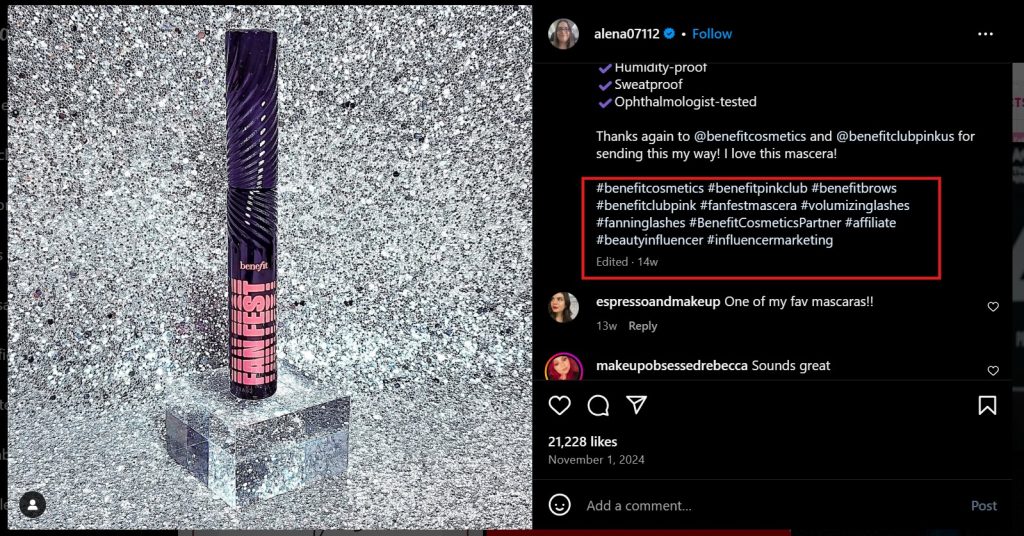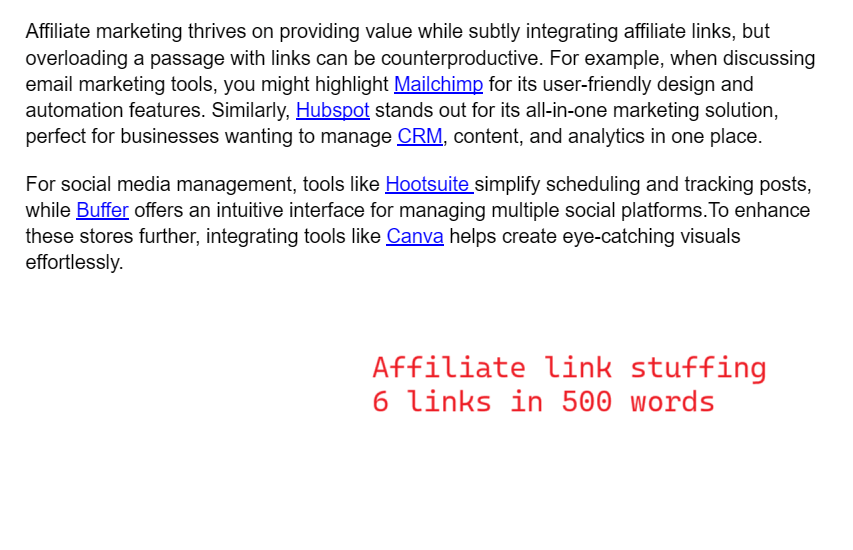Affiliate marketing has become a successful business worth over $17 billion (as of 2023); this is a big increase from $13 billion in 2016. At the heart of this strategy lies the affiliate links – a simple yet powerful tool that connects content creators with businesses while benefiting both parties.
But what exactly are affiliate links, and how do they work? In this article, we’ll break down the concept of affiliate links, explain how they work, and guide you through the steps to use them effectively!

What are affiliate links?
Affiliate links are unique URLs provided to affiliates by companies or merchants as part of an affiliate marketing program. These links are used to track the sales, leads, or clicks generated by the affiliate’s promotional efforts. Essentially, they serve as a digital identifier, connecting the affiliate’s content to the merchant’s website.
When someone clicks on an affiliate link and performs a desired action, such as making a purchase or signing up for a service – the affiliate earns a commission. This model benefits both the merchant, who gains more customers, and the affiliate, who gets rewarded for their efforts.
Affiliate links typically include:
- A unique ID or code: This tracks which affiliate drove the traffic or sale.
- The merchant’s website URL: This directs users to the specific product or service being promoted.
- Tracking parameters: These can include cookies, UTM codes, or other analytics tools to measure performance accurately.

This simplicity is what makes affiliate links so powerful, they’re easy to use, share, and track, making them an essential part of any affiliate marketing strategy.
How do affiliate links work?

Affiliate links are the backbone of affiliate marketing, enabling seamless tracking and rewarding of promotional efforts. Here’s a step-by-step breakdown of how affiliate links work:
Step 1: Affiliates sign up for an affiliate program
The affiliate joins an affiliate marketing program offered by a business or affiliate network. Once approved, they receive unique affiliate links to promote the business’s products or services.
Step 2: Promote the affiliate link
Affiliates share their unique links across various platforms, such as blogs, social media, YouTube videos, or email campaigns. The goal is to drive traffic to the merchant’s website through engaging and informative content.
Step 3: The customer clicks on the link
When a user clicks on the affiliate link, they are redirected to the merchant’s website. Simultaneously, tracking systems (like cookies or unique IDs) record the click and associate it with the affiliate.
Step 4: The customer completes an action
If the user completes a specific action, such as purchasing a product, subscribing to a service, or signing up for a newsletter – the affiliate link ensures that the affiliate is credited for the referral.
Step 5: Tracking and attribution
The merchant uses tracking technology to attribute the user’s action to the correct affiliate. This can include cookies (stored on the user’s browser for a specified time) or server-based tracking methods.
Step 6: Affiliate earns a commission
Once the action is verified, the affiliate earns a predetermined commission. This can be a percentage of the sale, a flat fee, or another reward based on the terms of the affiliate program.
Pretty simple, right?
Real-world examples of affiliate links
To better understand how affiliate links work, let’s explore a real-world example.
Imagine you are an affiliate for an online retailer, such as Amazon. As part of the Amazon Associates Program, you decide to promote a popular product – let’s say a fitness tracker. Here’s how an affiliate link would look in action:
Unique affiliate link
After logging into the affiliate dashboard, you generate a unique link for the fitness tracker. It might look something like this:
https://www.amazon.com/dp/productID?tag=youraffiliateID
The productID identifies the specific fitness tracker.
The tag=youraffiliateID is your unique tracking code, ensuring any purchases through this link are attributed to you.
Promotion
You include this link in various promotional channels, such as A blog post reviewing the fitness tracker, a YouTube video demonstrating its features, or a social media post recommending it as a holiday gift, etc
Conversion
Your audience clicks the affiliate link in your blog post. They are directed to Amazon’s product page, where they can view more details and make a purchase. If the reader buys the fitness tracker, or any other product during the same session, you earn a commission. Amazon’s affiliate program typically credits sales within 24 hours of the link being clicked.
Here’s how an affiliate link might look in an actual blog post:
“Looking for a reliable fitness tracker to stay on top of your health goals? Check out this top-rated fitness tracker – it’s stylish, accurate, and budget-friendly!”
How to use the affiliate link?
Using affiliate links effectively is crucial for maximizing your earnings while maintaining transparency and professionalism. Here’s a detailed guide to help you get started:
Step 1: Access your affiliate dashboard
Select an affiliate program that aligns with your niche or interests such as Amazon Associates or ClickBank – it depends on your network you are in. Complete the application process for the program. Provide accurate details about your platform (blog, social media, etc.), and wait for approval (Approval timelines vary depending on the program).
Once approved, log in to the affiliate dashboard provided by the program. Familiarize yourself with the interface, where you can track earnings, generate links, and monitor performance.
Step 2: Generate your unique affiliate link
Search for the product or service you want to promote within the dashboard, then use the link generator tool to create a unique affiliate link. Finally, shorten the link using tools like Bitly or TinyURL for a cleaner appearance.
Step 3: Add affiliate links to your promotion

Strategically place your affiliate links in your content to attract clicks and drive conversions. Here are some common methods:
- Blog Posts: Use anchor text (e.g., “Check out this fitness tracker here.”) to embed links naturally within your articles.
- Email Marketing: Include affiliate links in newsletters or promotional emails, ensuring they fit the content context.
- Social Media Posts: Share links in comments or captions where allowed. Avoid overly promotional language to maintain authenticity.
- Videos: Add affiliate links in the description box, pinned comments, or directly in the video (via annotations or embedded text).
- Embedded Links: For platforms like Pinterest, Stories, or TikTok, embed affiliate links directly into pins, reels, or video descriptions to make them easily accessible.
Note: For images or videos, you can embed affiliate links directly or modify them for detailed tracking (e.g., using tracking pixels or API integration). Some platforms may require additional tools like scripts for compliance and analytics.
Step 4: Disclosure rules
Transparency is essential when using affiliate links. Always disclose your affiliate relationship to build trust with your audience and comply with legal requirements, such as FTC guidelines.
Example disclosure: “This post contains affiliate links. I may earn a commission at no extra cost to you.”
Step 5: Track performance
Monitoring your affiliate link performance helps you optimize your strategy. Most affiliate dashboards provide analytics tools to:
- Track clicks, conversions, and earnings.
- Identify your best-performing links and platforms.
- Analyze user behavior to refine your content and promotion strategies.
What you must know when using affiliate links
While affiliate links are a great way to earn passive income, using them effectively requires awareness of certain key factors. Here are the most important things you need to know:
Always include an affiliate disclosure
Disclosing your affiliate relationships isn’t just good practice, it’s a legal requirement in many regions, such as under FTC guidelines in the U.S.
Place disclosures prominently in your content, such as:
- At the beginning of blog posts.
- In video descriptions or pinned comments.
- In email footers or directly in social media captions.
Use shortened links
Long affiliate links can look messy and unprofessional. Use link-shortening tools like Bitly, TinyURL, or the shortening feature in your affiliate program to make links cleaner and more appealing. Shortened links also improve click-through rates by appearing more trustworthy.
No-follow vs. Do-follow links
Use no-follow tags for affiliate links to comply with SEO best practices and avoid being penalized by search engines. This tells search engines not to pass “link juice” from your website to the merchant’s site.
Reserve do-follow links for cases where the linked content provides significant value to your readers and aligns with SEO strategies.

Affiliate link density in content
The number of affiliate links in your content should be balanced, as platforms may flag excessive links as spammy. It’s crucial to avoid overwhelming your audience with too many affiliate links, which could harm your credibility and SEO ranking.
Keep affiliate links to a reasonable number, such as 1–2 links per 500–800 words, depending on the content type.

A good alternative is to use a link-in-bio page (like Koji, Linktree, or Beacons) where you can showcase multiple products with affiliate links. This allows you to keep your content clean while still promoting various affiliate products effectively.
Affiliate link stack with discounts
Some affiliate programs allow you to stack discounts, meaning you can combine affiliate commission links with other promotional offers, such as a store’s first-purchase discount or seasonal sales. For example, a user could receive a 10% discount on a product through an affiliate link and also benefit from a first-time purchase discount.
However, not all affiliate programs allow discount stacking, so it’s important to read the terms and conditions carefully to ensure you’re following the rules.
Understand the rules of affiliate programs
Each affiliate program has its own rules and policies regarding link usage, content restrictions, and promotions. Familiarize yourself with these rules to avoid violations that could lead to account suspension or loss of commissions.
Here are some general examples of affiliate program rules that restrict link promotion methods:
- No Paid Ads: Some programs prohibit affiliates from using paid advertising (Google Ads, Facebook Ads) to drive traffic to their affiliate links.
- No link spamming on social media: Link spamming on social media may harms brand’s reputation.
- No Coupon Sites: Some brands don’t allow affiliates to list their links on coupon or deal websites.
- No Bidding on Brand Keywords – Many programs prohibit affiliates from bidding on branded keywords in search engine ads (e.g., “Nike shoes discount”).
UTM in affiliate link
Affiliate program’s rules may include guidance on adding UTM in affiliate links. Some programs allow affiliates to add UTM parameters for tracking purposes, while others prohibit any modification of affiliate links.
Many affiliate programs permit UTM tracking (e.g., ?utm_source=instagram&utm_medium=affiliate). This helps affiliates track traffic sources and campaign performance in Google Analytics.
Check the program’s terms or ask the affiliate manager before adding UTMs. If UTMs are not allowed, use third-party tracking tools like Bitly or Google Tag Manager to monitor performance. Pay attention to key metrics like click-through rates (CTR), conversion rates, and revenue.
Conclusion
Affiliate links are the essential for doing online affiliate marketing. It is indeed the backbone of your marketing game, whether you’re a blogger, influencer, or content creator. By understanding how affiliate links work and using them effectively, you can generate passive income while providing value to your audience.